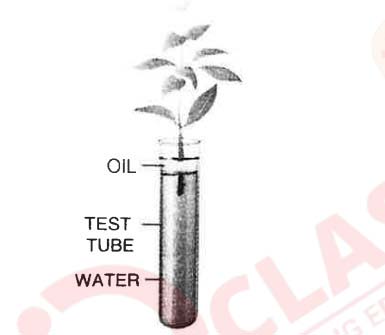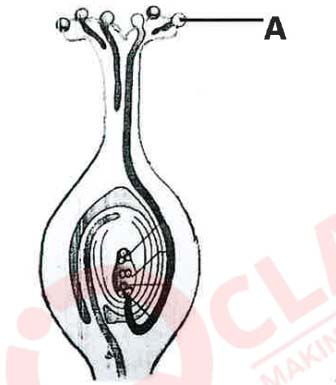Class 10 ICSE Biology Specimen 2023
Maximum Marks: 80
Time allowed: Two and half hours
Answers to this Paper must be written on the paper provided separately.
You will not be allowed to write during first 15 minutes.
This time is to be spent in reading the question paper.
The time given at the head of this Paper is the time allowed for writing the answers.
Section A is compulsory.
Attempt any four questions from Section B.
The intended marks for questions or parts of questions are given in brackets [ ].
Section-A
(Attempt all questions from this Section.)
Question 1
Choose one correct answer to the questions from the given options:
(i) A muscular wall is absent in:
(a) Capillary
(b) Arteriole
(c) Venule
(d) Vein
Solution

(ii) On which day of the menstrual cycle does ovulation take place?
(a) Ist day
(b) 5th day
(c) 14th day
(d) 28th day
Solution

(iii) Ganong’s Potometer is used to study:
(a) Photosynthesis
(b) Rate of uptake of water
(c) Exosmosis
(d) Guttation
Solution

(iv) The number of chromosomes in a human skin cell are:
(a) 22
(b) 23
(c) 44
(d) 46
Solution

(v) Cretinism and Myxedema are due to:
(a) Hypersecretion of thyroxine
(b) Hypersecretion of growth hormone
(c) Hyposecretion of thyroxine
(d) Hypersecretion of growth hormone
Solution

(vi) Light dependent phase of photosynthesis in green leaves takes place in:
(a) Grana of chloroplast
(b) Stroma of chloroplasm
(c) Nucleus of palisade cells
(d) Cytoplasm of palisade cells
Solution

(vii) An example of a biodegradable substance is:
(a) Aluminium
(b) Paper
(c) Plastic
(d) Steel
Solution

(viii) The part that is cut in Vasectomy is:
(a) Urethra
(b) Oviduct
(c) Fallopian tube
(d) Vas deferens
Solution

(ix) Gestation period of human foetus is:
(a) 40 days
(b) 280 days
(c) 280 weeks
(d) 40 months
Solution

(x) The part of the human eye where the rods and cones are located is:
(a) Iris
(b) Retina
(c) Sclera
(d) Choroid
Solution

(xi) Organ of Corti is present in:
(a) Utriculus
(b) Sacculus
(c) Cochlea
(d) Incus
Solution

(xii) The outermost covering of the brain is:
(a) Arachnoid
(b) Piamater
(c) Pericardium
(d) Duramater
Solution

(xiii) Cytokinins are predominantly present in:
(a) Meristematic tissues
(b) Permanent tissues
(c) Endodermis
(d) Epidermis
Solution

(xiv) Marine fish when placed in tap water bursts because of:
(a) Diffusion
(b) Plasmolysis
(c) Endosmosis
(d) Exosmosis
Solution

(xv) Urine is carried from kidney to urinary bladder by:
(a) Uterus
(b) Urethra
(c) Umbilical cord
(d) Ureter
Solution

Question 2
(i) Name the following:
(a) The suppressed allele of a gene.
(b) The knot like mass of blood capillaries in Bowman’s capsule.
(c) The mineral element required for the synthesis of thyroxine.
(d) One gaseous compound that depletes the ozone layer.
(e) The statistical study of human population.
(ii) Arrange and rewrite the terms in each group in the correct order so as to be in a
logical sequence beginning with the term that is underlined.
(a) Soil water, Xylem, Root hair, Cortex
(b) Tympanum, Incus, Malleus, Stapes
(c) Pulmonary Vein, Left Ventricle, Aorta, Left auricle
(d) Sperm, Urethra, Sperm duct, Epididymis
(e) Aqueous humour, Optic nerve, Retina, Lens
(iii) Match the items given in Column I with the most appropriate ones in Column II and
rewrite the correct matching pairs.

(iv) Choose the odd one out from the following terms and name the category to which
the others belong:
(a) Thyroid gland, Lacrimal gland, Pituitary gland, Adrenal gland.
(b) Detergents, Sewage, X-rays, Oil spills
(c) Spinal cord, Cerebrum, Pons, Cerebellum
(d) Chloroplast, Cell wall, Large Vacuoles, Centrosome.
(e) Auxin, Oxytocin, Gibberellin, Cytokinin
(v) State the exact location of the following structures:
(a) Thylakoids
(b) Corpus callosum
(c) Chordae tendinac
(d) Prostate gland
(e) Adrenal glands
Solution









Section-B
(Attempt any four questions from this Section.)
Question 3
(i) Define Guttation.
(ii) Give one difference between Lenticels and Stomata.
(iii) What is Parthenocarpy? Give one example.
(iv) State Mendel’s Law of Segregation.
(v) Study the diagram given below and answer the questions that follow:

(a) Name process being studied in the above experiment.
(b) What will you observe with regard to the level of water when this setup is placed
in bright sunlight.
(c) Mention one adaptation found in plants to overcome the process mentioned in (i).
Solution





Section-B
(Attempt any four questions from this Section.)
Question 4
(i) Expand the abbreviation — A T P.
(ii) Name any two nitrogenous bases.
(iii) Addition of salt to pickles prevents the growth of bacteria. Explain by giving two
suitable reasons.
(iv) Mention two adaptations in leaves to perform Photosynthesis.
(v) Given below is a diagram representing a stage during the mitotic cell division.
Answer the following questions:

(a) Identify the stage.
(b) Give a suitable reason for your answer in (a).
(c) Name the stage that follows the one shown in the diagram.
Solution




Question 5
(i) Define — Excretion.
(ii) What is the significance of Hepatic Portal Vein?
(iii) State two functions of vitreous humour.
(iv) Which gland secretes Glucagon? What is its effect on blood sugar level?
(v) Draw a neat labelled diagram to show the internal structure of a human kidney.
Solution






Question 6
(i) Define — Gene.
(ii) Differentiate between Cell wall and Cell membrane with reference to permeability.
(iii) State the function of Medulla Oblongata with a suitable example.
(iv) Colour blindness is generally seen in males. Explain.
(v) Study the diagram given below and answer the questions that follow:

(a) Identify the structure.
(b) In which part of the ear is it located?
(c) What is the function of the part marked A?
Solution





Question 7
(i) Explain — Accommodation of eye.
(ii) Give two reasons for a sharp rise in world human population.
(iii) Mention two functions of Amniotic fluid.
(iv) What is the difference between Phenotype and Genotype?
(v) Draw neat labelled diagrams showing the cross sections of an Artery and a Vein.
Solution





Question 8
(i) Define — Pollution.
(ii) Plants droop on a hot day even though the soil is well watered. Explain.
(iii) Differentiate between Menarche and Menopause.
(iv) State two harmful effects of acid rain
(v) The diagram given below shows a type of tropism. Answer the questions that follow:

(a) Name the type of tropism.
(b) Define the above mentioned tropism.
(c) Give an example ofa stimulant that helps in the growth of the part marked — A.
Solution






Add a comment